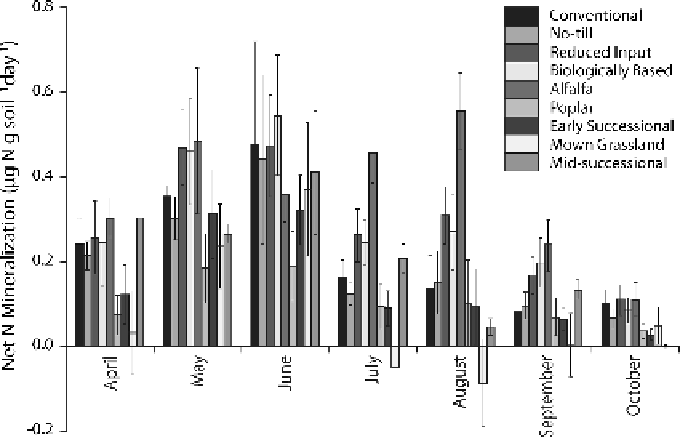Agriculture Reference
In-Depth Information
Figure 9.6
. Net N mineralization rates (μg N g soil
-1
day
-1
) during the growing season
(April to October) in the MCSE systems for 1989-1995 (except no data 1991). Mean ± SE
for all measurements within each month.
Nitrosospira
cluster 3. On the other hand, Bruns et al. (1999) did find more, but less
diverse, culturable ammonia oxidizers (also
Nitrosospira
) in Conventional system
soils than in Early Successional or Mown Grassland (never tilled) systems. The
recent discovery of Archaeal nitrifiers and their likely prevalence in many soils
promises to transform our community-level understanding of nitrifiers at the KBS
LTER as elsewhere (Robertson and Groffman 2015).
In most aerated soils, nitrification is controlled primarily by factors that affect
NH
4
+
availability and rates can be inferred by measuring changes in NH
4
+
and
NO
3
−
in soil incubations. In most soil incubations, where plant uptake and leaching
losses are excluded, much of the mineralized N typically ends up as NO
3
−
rather
than NH
4
+
(Robertson and Groffman 2015). In all annual cropping systems as well
as the Alfalfa and Deciduous Forest systems, the proportion of net mineralized N
that exists as NO
3
−
at the end of the incubation—here called relative nitrification
(Robertson et al. 1999)—is high (70-80%, Table 9.5), indicating rapid nitrifica-
tion of NH
4
+
as it is formed during mineralization. In contrast, relative nitrification
is low (28-42%) in the Poplar, Early Successional, Mid-successional, and Mown
Grassland (never tilled) systems. Low relative nitrification may reflect edaphic,
plant, or other conditions that affect nitrifier communities or otherwise delay
nitrification.
Nitrification is typically rapid in cultivated soils and may be regarded as a gate-
way to N loss (Robertson 1982); only after NH
4
+
is transformed into NO
3
−
is N
readily lost from most ecosystems. Nitrate can be quickly leached from soils and
also serves as the substrate for denitrification, which produces the gases N
2
and N
2
O.

